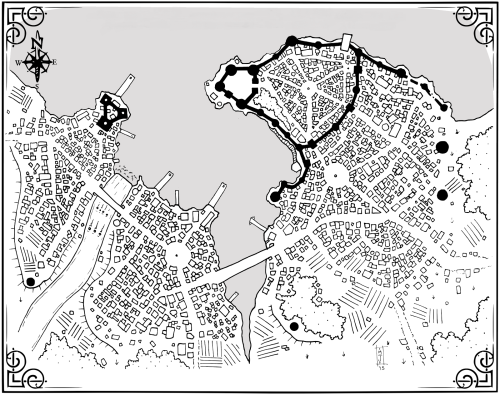San Francillieth
City of Monuments; and Old World Blues
Surviving since before Elidyr's Folly – the last battle of the Godswar – the City of Skilled Hands has only sustained itself due to combined efforts of its inhabitants. Broken marblework has been replaced by makeshift mud-brick construction, creating the impression that a new town is slowly emerging from the ruins of the old that have sunk into the Dragondown Coast.
The City of 1000 Gods is now a messy-rebuilt maze of alleys, ghettos, rivers, dungeons, and catacombs, with boroughs built in different decades by different races from different regions who spoke different languages. Large portions of the town can still reek of death and the remnants of arcane battles. Sometimes entire wards are left abandoned, unlivable thanks to the powerful corrosive acids, magical fires, and lethal poisons that still linger.
Yet the city is constantly alight with activity. Among the inward facing residental complexes and plazas; conversation can be difficult outdoors, as the tireless street barkers and marketeers try to pull attention away from the general buzz of trampling feet and sounds of production. And while the Ruling Families' pledge guard do a passable job of defending the city against monsters and brigands from beyond its walls, some believe the true threat to the fragile peace comes from within the city itself.
Infrastructure
San Francillieth's worst illusion is that all of the tribal families are equal. That all the families rely on one one another to survive which helps create social and professional links between Tribes of different standings. And that through innovation and merit, one can improve their standing.
Heads of households are lavish gold decorations ensure that order is maintained. While leaders in their "fields" of society (such as High Priests or Chief Artisans) act as councilers to these householder of the city.
And below them are a servant caste - families born to serve higher rungs of society. They are farmers, laborers, maids, and cooks seen as the most “adaptable” folk of San Francillieth.
The casteless - tribeless indidivuals - provide someone for even the most “adaptable” caste to look down upon which helps keep them content with their place in life.
Districts
The High Canton
Built atop a 200-foot-tall bluff that ruptured from the earth long ago, like a dagger plunged into the earth. A thousand steps separate Hightown from the remains of San Francillieth – where the Ruling Families prosper beyond dreams of avarice. People in Hightown feel safe, not because the city's walls are impregnable, but because an invader would need to scale the stairs from Lowtown to reach them. Statues and carvings decorate the fortified villas of the Ruling Families, overlooking the rest of the burgh, and overgrown with rooftop gardening.The Fallcrest
The Fallcrest neighborhoods serves primarily as housing for the city's most “adaptable” caste as well as the city's industrial center. A maze of towering residental complex that is constantly crowded and bustling with activity – even deep into the night. It is akin to peering into an insect hive - the city is packed and crowded with people traversing its streets in hectic fashion. Several neighborhoods' surfaces are awash with the varying and rich scent of metals, wood, herbs, baked goods, potent spices, and other vibrant smells produced by the city’s numerous craftsmen and ancestral shrines. Each attempting to be sponsored by the Ruling Families. Even the neighborhoods like the Midnight's Muddle look down upon the casteless - considering themselves and their work worthy of the greatest respect and take pride in their service to other Tribes.The Beggar's Cairn
The shanty town in the broken remains of the Old World. The most diverse of the township's districts – where Kith simply struggle to survive. During the raining seasons the district floods up to the hip, requiring rickshaws to get around. None here are Family-Sponsored, with many turning to economic gangs and religious cults for protection and opportunity. An eerie silence hangs overhead, as wary eyes behind ramshackle stalls and handcarts offer their wares. In general, the less attention that’s drawn to oneself, the better. Every proffered hand obscures its true intent, serving as a distraction for larceny or robbery just as often as vital assistance or honest sale.Between the Haves, and Have-Nots, and the Necessitous; They believe creating items, especially statues, is the best way to celebrate their ancestors or local spirits, not the Gods.
Jewellery, often of gold, is a very important element in Francillieth culture. Powerful and wealthy individuals wear several necklaces, rings and bracelets, large in size and of pure gold. Influential indidivuals wear fine, elegently cut Glamerweave clothings - while everyone uses a lot of beads not just for jewelry but for the clothing itself. Often it’s of coral but many other materials, more or less precious, are used as well.
An additional distinguisher of authority and seniority are “crowns” which are black hats covered in gold ornaments. Some crowns are long and pointed while others sit low like a cap. Ancestor or worshipping leaders are recognized by their tall hats and the regalia they hold.
Maps
-
San Francillieth
A township built from the ruins of a larger metropolis; San Francillieth acts as one of the last bastions of civilization in this ruined land. Kept alive only by the combined efforts of its inhabitants.
The 12 Tribes of San Francillieth:
Ruling Families:
- The Cassalanter Family
- The Dran Family
- The Alagondar Family
- The Sedarnels Family
- The Vorzin Family
Remaining Tribes:
- The Olidammara Tribe
- The Sun Dogs
- The Twin Mothers
- The Crow's Tribe
- The Obad-Hai
- The Vanthampur
- The Rao Tribe
Remove these ads. Join the Worldbuilders Guild












Comments
Author's Notes
I use primarily Ethiopian Names for humans in the Dragondown Coast. This is meant to emphasize the nontradition Angelo-Saxon aspect of the setting.